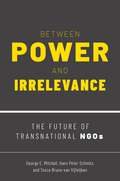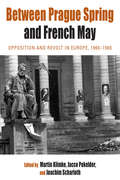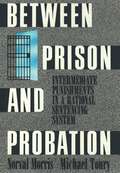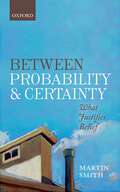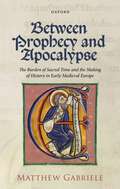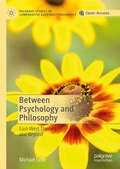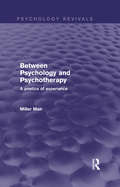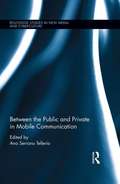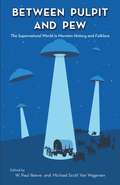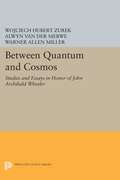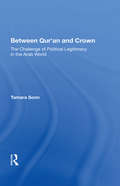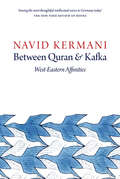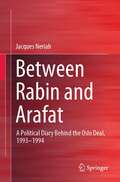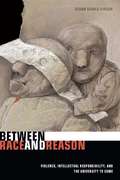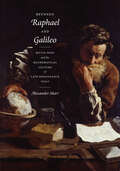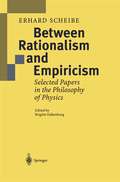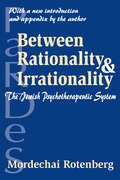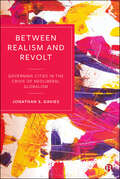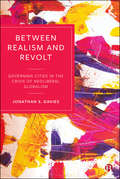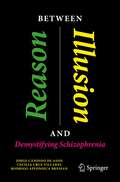- Table View
- List View
BETWEEN POWER AND IRRELEVANCE C: The Future of Transnational NGOs
by George E. Mitchell Hans Peter Schmitz Tosca Bruno-van VijfeijkenGeopolitical shifts, increasing demands for accountability, and growing competition have been driving the need for change within transnational nongovernmental organizations (TNGOs). As the world has changed and TNGOs' ambitions have expanded, the roles of TNGOs have shifted and their work has become more complex. To remain effective, legitimate, and relevant in the future necessitates organizational changes, but many TNGOs have been slow to adapt. As a result, the sector's rhetoric of sustainable impact and social transformation has far outpaced the reality of TNGOs' more limited abilities to deliver on their promises. Between Power and Irrelevance openly explores why this gap between rhetoric and reality exists and what TNGOs can do individually and collectively to close it. George E. Mitchell, Hans Peter Schmitz, and Tosca Bruno-van Vijfeijken argue that TNGOs need to change the fundamental conditions under which they operate by bringing their own "forms and norms" into better alignment with their ambitions and strategies. This book offers accessible, future-oriented analyses and lessons-learned to assist practitioners and other stakeholders in formulating and implementing organizational changes. Drawing upon a variety of perspectives, including hundreds of interviews with TNGO leaders, firsthand involvement in major organizational change processes in leading TNGOs, and numerous workshops, training institutes, consultancies, and research projects, the book examines how to adapt TNGOs for the future.
Between Prague Spring and French May: Opposition and Revolt in Europe, 1960-1980 (Protest, Culture & Society #7)
by Martin Klimke Jacco Pekelder Joachim ScharlothAbandoning the usual Cold War–oriented narrative of postwar European protest and opposition movements, this volume offers an innovative, interdisciplinary, and comprehensive perspective on two decades of protest and social upheaval in postwar Europe. It examines the mutual influences and interactions among dissenters in Western Europe, the Warsaw Pact countries, and the nonaligned European countries, and shows how ideological and political developments in the East and West were interconnected through official state or party channels as well as a variety of private and clandestine contacts. Focusing on issues arising from the cross-cultural transfer of ideas, the adjustments to institutional and political frameworks, and the role of the media in staging protest, the volume examines the romanticized attitude of Western activists to violent liberation movements in the Third World and the idolization of imprisoned RAF members as martyrs among left-wing circles across Western Europe.
Between Prison and Probation: Intermediate Punishments in a Rational Sentencing System
by Norval Morris Michael TonryAcross the country prisons are jammed to capacity and, in extreme cases, barges and mobile homes are used to stem the overflow. Probation officers in some cities have caseloads of 200 and more--hardly a manageable number of offenders to track and supervise. And with about one million people in prison and jail, and two and a half million on probation, it is clear we are experiencing a crisis in our penal system. In Between Prison and Probation, Norval Morris and Michael Tonry, two of the nation's leading criminologists, offer an important and timely strategy for alleviating these problems. They argue that our overwhelmed corrections system cannot cope with the flow of convicted offenders because the two extremes of punishment--imprisonment and probation--are both used excessively, with a near-vacuum of useful punishments in between. Morris and Tonry propose instead a comprehensive program that relies on a range of punishment including fines and other financial sanctions, community service, house arrest, intensive probation, closely supervised treatment programs for drugs, alcohol and mental illness, and electronic monitoring of movement. Used in rational combinations, these "intermediate" punishments would better serve the community than our present polarized choice. Serious consideration of these punishments has been hindered by the widespread perception that they are therapeutic rather than punitive. The reality, however, Morris and Tonry argue, "is that the American criminal justice system is both too severe and too lenient--almost randomly." Systematically implemented and rigorously enforced, intermediate punishments can "better and more economically serve the community, the victim, and the criminal than the prison terms and probation orders they supplant." Between Prison and Probation goes beyond mere advocacy of an increasing use of intermediate punishments; the book also addresses the difficult task of fitting these punishments into a comprehensive, fair and community-protective sentencing system.
Between Probability and Certainty: What Justifies Belief
by Martin SmithMartin Smith explores a question central to philosophy—namely, what does it take for a belief to be justified or rational? According to a widespread view, whether one has justification for believing a proposition is determined by how probable that proposition is, given one's evidence. In the present book this view is rejected and replaced with another: in order for one to have justification for believing a proposition, one's evidence must normically support it—roughly, one's evidence must make the falsity of that proposition abnormal in the sense of calling for special, independent explanation. This conception of justification bears upon a range of topics in epistemology and beyond, including the relation between justification and knowledge, the force of statistical evidence, the problem of scepticism, the lottery and preface paradoxes, the viability of multiple premise closure, the internalist/externalist debate, the psychology of human reasoning, and the relation between belief and degrees of belief. Ultimately, this way of looking at justification guides us to a new, unfamiliar picture of how we should respond to our evidence and manage our own fallibility. This picture is developed here.
Between Prophecy and Apocalypse: The Burden of Sacred Time and the Making of History in Early Medieval Europe
by Matthew GabrieleThe tenth and eleventh centuries in medieval Europe are commonly seen as a time of uncertainty and loss: an age of lawless aristocrats, of weak political authority, of cultural decline and dissolute monks, and of rampant superstition. It is a period often judged from its margins, compared (mostly negatively) to what came before and what would follow. We impose upon it both a sense of nostalgia and a teleology, as they somehow knowingly foreshadow what is to come. Seeking to complicate this mischaracterisation, which is primarily the invention of nineteenth and early twentieth century historiography, this book maps the movement between two intellectual stances: a shift from prophetic to apocalyptic thinking. Although the roots of this change lay in Late Antiquity, the fulcrum of this transition lies in the tenth and eleventh centuries. Biblical commentators in the fourth and fifth centuries enforced a particular understanding of sacred time that held until the ninth century, when exegetes of the ninth century found in their commentaries a different plan for God's new chosen people. This came into stark relief as the new kingdom of Israel (the Frankish empire under the Carolingians) had splintered in the 840s. God was manifesting his displeasure with the chosen people by fire and sword. What was perhaps unforeseen was that these commentaries that were written in the specific context of the Carolingian Civil War would be heavily copied and read for the next 200 years. Ideas that formed in a world that actively lamented the loss of empire had to be translated to a world that could only dream of that empire. As they spread across Europe, these ideas became the basis for monastic educational practices, and bled into other types of textual production, such as supposedly "secular" histories. Between Prophecy and Apocalypse charts an intellectual transformation triggered when the prescriptions laid out towards the end of the Carolingian empire began to be "realized" in subsequent centuries. Nostalgia entwined with an attentiveness to possible futures and spun together so tightly as to become a double helix. Ultimately, this book will offer a way to understand the central Middle Ages, a period of dynamic intellectual ferment when ideas could inspire action and (seemingly banal) conceptions of time and history could inspire moments of dramatic transformation and horrific violence.
Between Prophecy and Apocalypse: The Burden of Sacred Time and the Making of History in Early Medieval Europe
by Matthew GabrieleThe tenth and eleventh centuries in medieval Europe are commonly seen as a time of uncertainty and loss: an age of lawless aristocrats, of weak political authority, of cultural decline and dissolute monks, and of rampant superstition. It is a period often judged from its margins, compared (mostly negatively) to what came before and what would follow. We impose upon it both a sense of nostalgia and a teleology, as they somehow knowingly foreshadow what is to come. Seeking to complicate this mischaracterisation, which is primarily the invention of nineteenth and early twentieth century historiography, this book maps the movement between two intellectual stances: a shift from prophetic to apocalyptic thinking. Although the roots of this change lay in Late Antiquity, the fulcrum of this transition lies in the tenth and eleventh centuries. Biblical commentators in the fourth and fifth centuries enforced a particular understanding of sacred time that held until the ninth century, when exegetes of the ninth century found in their commentaries a different plan for God's new chosen people. This came into stark relief as the new kingdom of Israel (the Frankish empire under the Carolingians) had splintered in the 840s. God was manifesting his displeasure with the chosen people by fire and sword. What was perhaps unforeseen was that these commentaries that were written in the specific context of the Carolingian Civil War would be heavily copied and read for the next 200 years. Ideas that formed in a world that actively lamented the loss of empire had to be translated to a world that could only dream of that empire. As they spread across Europe, these ideas became the basis for monastic educational practices, and bled into other types of textual production, such as supposedly "secular" histories. Between Prophecy and Apocalypse charts an intellectual transformation triggered when the prescriptions laid out towards the end of the Carolingian empire began to be "realized" in subsequent centuries. Nostalgia entwined with an attentiveness to possible futures and spun together so tightly as to become a double helix. Ultimately, this book will offer a way to understand the central Middle Ages, a period of dynamic intellectual ferment when ideas could inspire action and (seemingly banal) conceptions of time and history could inspire moments of dramatic transformation and horrific violence.
Between Psychology and Philosophy: East-West Themes and Beyond (Palgrave Studies in Comparative East-West Philosophy)
by Michael SloteThis open access book discusses a variety of important but unprecedented ways in which psychology can be useful to philosophy. The early chapters illustrate this theme via comparisons between Chinese and Western philosophy. It is argued that the Chinese notion of a heart-mind is superior to the Western concept of mind, but then, more even-handedly, the relative strengths and weaknesses of Chinese and Western thought overall are critically examined. In later chapters, the philosophical uses of psychology are treated more specifically in relation to major issues in Western philosophy. Michael Slote shows that empathy and emotion play a role in speech acts (like assertion and thanking) that speech act theory has totally ignored. Similarly, he treats the age-old question of whether justice pays using psychological material that has not previously been recognized. Finally, the implications of psychological egoism are discussed in terms of some new psychological and, indeed, human distinctions. Human life is pervaded by instincts and aspirations that are neither egoistic nor altruistic, and recognizing that fact can help put egoism in its place. It is less of a challenge to morality than we have realized.
Between Psychology And Psychotherapy: A Poetics Of Experience (PDF)
by Miller MairIn this highly original and thought-provoking work the late Miller Mair puts forward his ideas for a new psychology. First published in 1989, he deals with issues of fundamental importance to the future of a psychology guided by genuine enquiry and concern rather than mere professional self-interest. Crossing and re-crossing boundaries between psychology, psychotherapy and philosophy, and between ‘science’ and ‘art’, he demonstrates the linkages between the personal and the impersonal, subject and object, inside and outside, with a daring not previously risked by anyone working in the area. Dr Mair stresses the importance of a poetic approach in psychology and psychotherapy, and the need to explore and understand the nature of psychology through an imaginative freedom of language. He emphasizes that a poetic awareness and attentiveness is fundamental to any pursuit of understanding of ourselves or others. This is a very personal book, concerned with personal knowledge, but it is meant for anyone who seeks to understand themselves and others, and what is involved in coming to such understanding. Focusing on ordinary human experience, and moving towards literary and artistic modes of expression, the author invites you to enter in, follow what you think and feel, as he proposes a radical revision of much that is accepted in psychology and in psychotherapy.
Between Psychology And Psychotherapy: A Poetics Of Experience
by Miller MairIn this highly original and thought-provoking work the late Miller Mair puts forward his ideas for a new psychology. First published in 1989, he deals with issues of fundamental importance to the future of a psychology guided by genuine enquiry and concern rather than mere professional self-interest. Crossing and re-crossing boundaries between psychology, psychotherapy and philosophy, and between ‘science’ and ‘art’, he demonstrates the linkages between the personal and the impersonal, subject and object, inside and outside, with a daring not previously risked by anyone working in the area. Dr Mair stresses the importance of a poetic approach in psychology and psychotherapy, and the need to explore and understand the nature of psychology through an imaginative freedom of language. He emphasizes that a poetic awareness and attentiveness is fundamental to any pursuit of understanding of ourselves or others. This is a very personal book, concerned with personal knowledge, but it is meant for anyone who seeks to understand themselves and others, and what is involved in coming to such understanding. Focusing on ordinary human experience, and moving towards literary and artistic modes of expression, the author invites you to enter in, follow what you think and feel, as he proposes a radical revision of much that is accepted in psychology and in psychotherapy.
Between The Public And Private In Mobile Communication (PDF)
by Ana Serrano TelleríaMobile devices' impact on daily life has raised relevant questions regarding public and private space and communication. Both the technological environment (operating systems, platforms, apps) and media ecosystems (interface design, participatory culture, social media) influence how users deal with the public and private, intimate and personal spheres. Leading researchers in communication, art, computer engineering, education, law, sociology, philosophy, and psychology here explore current methodologies for studying the dichotomy of the public and private in mobile communication, providing a foundation for further research.
Between Pulpit and Pew: The Supernatural World in Mormon History and Folklore
by W. Paul Reeve Michael Scott Van WagenenCain wanders the frontier as a Bigfoot-like hairy beast and confronts an early Mormon apostle. An evil band of murderers from Mormon scripture, known as the Gadianton robbers, provides an excuse for the failure of a desert town. Stories of children raised from the dead with decayed bodies and damaged minds help draw boundaries between the proper spheres of human and divine action. Mormons who observe UFOs in the nineteenth and twentieth centuries find ways to explain them in relation to the church’s cosmology. The millenarian dimension of that belief system induces church members to invest in the Dream Mine, a hidden treasure that a would-be heir to Joseph Smith wraps in prophecy of the end times. A Utah version of Nessie haunts a large mountain lake. Non-Mormons attempt to discredit Joseph Smith with tales that he had tried and failed to walk on water. Mormons gave distinctive meanings to supernatural legends and events, but their narratives incorporated motifs found in many cultures. Many such historical legends and beliefs found adherents down to the present. This collection employs folklore to illuminate the cultural and religious history of a people.
Between Quantum and Cosmos: Studies and Essays in Honor of John Archibald Wheeler (PDF)
by Alwyn van der Merwe Wojciech Hubert Zurek Warner Allen MillerThe forty papers collected here honor one of the great scientists of our time--John Archibald Wheeler. In this volume are gathered the six issues of the journal Foundations of Physics (February through July 1986) that celebrate his seventy-fifth birthday. Enlivened by Professor Wheeler's celebrated drawings, the book captures and illuminates his many contributions to physics, including his discovery of the scattering matrix and his elucidation, with Niels Bohr, of the mechanism of nuclear fission, his many contributions to Einstein's theory of gravity (for instance, the black hole), his deep insights into quantum theory and measurement (the elementary quantum phenomenon), and his efforts to explain the origins of the quantum postulate and quantum gravity (the meaning circuit and the Wheeler-DeWitt Equation). The majority of the papers reflect and build on Professor Wheeler's revolutionary ideas. Many scientists are convinced that his insights into the foundation of modern-day physics will induce a profound change in our perception of the universe. This book will appeal to scientists and philosophers who wish to look at one man's rendering of the "big picture" through the eyes of his colleagues. The work is prefaced by a compilation of quotes from Professor Wheeler, edited by Kip S. Thorne and Wojciech Zurek. The contributors to Between Quantum and Cosmos are M. Alexander, A. Anderson, H. H. Barschall, J. D. Bekenstein, C. H. Bennett, P. G. Bergmann, V. B. Braginsky, D. R. Brill, L. Brown, I. Ciufolini, L. Cohen, M. Demianski, D. Deutsch, B. DeWitt, C. DeWitt-Morette, R. H. Dicke, B. d'Espagnat, R. P. Feynman, J. Geheniau, U. H. Gerlach, R. Geroch, J. Glimm, J. B. Hartle, F. W. Hehl, M. Henneaux, P. A. Hogan, S. Hojman, J. Isenberg, F. Ya. Khalili, A. Kheyfets, K. V. Kuchar, R. Landauer, S. G. Low, V. N. Lukash, B. Mashhoon, R. A. Matzner, J. D. McCrea, A. Mezzacappa, W. A. Miller, Y. Ne'eman, I. D. Novikov, A. Peres, I. Prigogine, I. Robinson, L. S. Schulman, M. O. Scully, D. H. Sharp, L. C. Shepley, A. Y. Shiekh, C. Teitelboim, E. Teller, K. S. Thorne, W. G. Unruh, R. M. Wald, L. Wilets, W. K. Wootters, J. W. York, Jr., and W. H. Zurek.Originally published in 1988.The Princeton Legacy Library uses the latest print-on-demand technology to again make available previously out-of-print books from the distinguished backlist of Princeton University Press. These editions preserve the original texts of these important books while presenting them in durable paperback and hardcover editions. The goal of the Princeton Legacy Library is to vastly increase access to the rich scholarly heritage found in the thousands of books published by Princeton University Press since its founding in 1905.
Between Qur'an And Crown: The Challenge Of Political Legitimacy In The Arab World
by Tamara SonnThe struggle for political legitimacy in many Middle Eastern countries today poses a dilemma for ruling elites. In order to maintain authority, leaders often must capitulate to Islamic universalist dogma, which may conflict with their own views of the state as well as threaten the legitimacy of other leaders in the region who are attempting to establish a secular, national basis for government. Tracing the roots of this dilemma in Middle Eastern history and Islamic philosophy, Dr. Sonn compares the contemporary Middle Eastern period to Europe’s “Age of Religious Wars†that preceded the emergence of the Western secular state. She describes how a process similar to the organic development of the secular state in Europe was interrupted in the Middle East by oppressive Western colonialism, which eventually led to the Muslim rejection of nationalism and all things “Western†and to the reassertion of Islam as the sole source of political legitimacy. The author shows how the philosophy of Islamic traditionalism opposes the two fundamentals of stable national political systems—a geographical limitation of authority and an institutionalized process for regular changes in leadership. Dr. Sonn bases her argument on an insightful examination of Middle Eastern history, from the formation and disintegration of the Ottoman Empire in the late nineteenth century to the present, and caps it with a detailed look at a possible solution to the dilemma: the teachings of modern scholars who advocate a new “Islamic realism†incorporating a limited definition of national identity and interests while retaining Islamic social goals.
Between Qur'an And Crown: The Challenge Of Political Legitimacy In The Arab World
by Tamara SonnThe struggle for political legitimacy in many Middle Eastern countries today poses a dilemma for ruling elites. In order to maintain authority, leaders often must capitulate to Islamic universalist dogma, which may conflict with their own views of the state as well as threaten the legitimacy of other leaders in the region who are attempting to establish a secular, national basis for government. Tracing the roots of this dilemma in Middle Eastern history and Islamic philosophy, Dr. Sonn compares the contemporary Middle Eastern period to Europe’s “Age of Religious Wars†that preceded the emergence of the Western secular state. She describes how a process similar to the organic development of the secular state in Europe was interrupted in the Middle East by oppressive Western colonialism, which eventually led to the Muslim rejection of nationalism and all things “Western†and to the reassertion of Islam as the sole source of political legitimacy. The author shows how the philosophy of Islamic traditionalism opposes the two fundamentals of stable national political systems—a geographical limitation of authority and an institutionalized process for regular changes in leadership. Dr. Sonn bases her argument on an insightful examination of Middle Eastern history, from the formation and disintegration of the Ottoman Empire in the late nineteenth century to the present, and caps it with a detailed look at a possible solution to the dilemma: the teachings of modern scholars who advocate a new “Islamic realism†incorporating a limited definition of national identity and interests while retaining Islamic social goals.
Between Quran and Kafka: West-Eastern Affinities
by Navid KermaniWhat connects Shiite passion plays with Brecht's drama? Which of Goethe's poems were inspired by the Quran? How can Ibn Arabi's theology of sighs explain the plays of Heinrich von Kleist? And why did the Persian author Sadeq Hedayat identify with the Prague Jew Franz Kafka? 'One who knows himself and others will here too understand: Orient and Occident are no longer separable': in this new book, the critically acclaimed author and scholar Navid Kermani takes Goethe at his word. He reads the Quran as a poetic text, opens Eastern literature to Western readers, unveils the mystical dimension in the works of Goethe and Kleist, and deciphers the political implications of theatre, from Shakespeare to Lessing to Brecht. Drawing striking comparisons between diverse literary traditions and cultures, Kermani argues for a literary cosmopolitanism that is opposed to all those who would play religions and cultures against one another, isolating them from one another by force. Between Quran and Kafka concludes with Kermani's speech on receiving Germany's highest literary prize, an impassioned plea for greater fraternity in the face of the tyranny and terrorism of Islamic State. Kermani's personal assimilation of the classics gives his work that topical urgency that distinguishes universal literature when it speaks to our most intimate feelings. For, of course, love too lies 'between Quran and Kafka'.
Between Quran and Kafka: West-Eastern Affinities
by Navid KermaniWhat connects Shiite passion plays with Brecht's drama? Which of Goethe's poems were inspired by the Quran? How can Ibn Arabi's theology of sighs explain the plays of Heinrich von Kleist? And why did the Persian author Sadeq Hedayat identify with the Prague Jew Franz Kafka? 'One who knows himself and others will here too understand: Orient and Occident are no longer separable': in this new book, the critically acclaimed author and scholar Navid Kermani takes Goethe at his word. He reads the Quran as a poetic text, opens Eastern literature to Western readers, unveils the mystical dimension in the works of Goethe and Kleist, and deciphers the political implications of theatre, from Shakespeare to Lessing to Brecht. Drawing striking comparisons between diverse literary traditions and cultures, Kermani argues for a literary cosmopolitanism that is opposed to all those who would play religions and cultures against one another, isolating them from one another by force. Between Quran and Kafka concludes with Kermani's speech on receiving Germany's highest literary prize, an impassioned plea for greater fraternity in the face of the tyranny and terrorism of Islamic State. Kermani's personal assimilation of the classics gives his work that topical urgency that distinguishes universal literature when it speaks to our most intimate feelings. For, of course, love too lies 'between Quran and Kafka'.
Between Rabin and Arafat: A Political Diary Behind the Oslo Deal, 1993–1994
by Jacques NeriahThis book shares first-hand insights into the implementation of the Oslo Accords between Israel and the Palestinians, written by a high-ranking Israeli military intelligence officer and former foreign policy advisor to Israel’s fifth prime minister, Yitzhak Rabin. It offers a diary of the political events surrounding the Israeli prime minister in 1993–1994, focusing on a key turning point in the Israeli-Arab conflict – those crucial days when Rabin had to choose between promoting a peace process with the Palestinians or trying to strike a deal with the Syrians and waiting for the Jordanians to join. The book sheds new light on Rabin’s attitudes towards the Palestinians, on his meetings with Yasser Arafat, and on what went on behind the scenes of the official diplomatic negotiations. Readers will learn about the power struggles and ego-driven rivalries between Israeli politicians and high-ranking generals, about the relationship between politicians and the media, and about problems such as the leaking of sensitive information to the press. This book will be of interest not only to scholars, but also and more importantly to policymakers around the world, and to anyone interested in the Israeli-Palestinian conflict and finding a two-state solution in the region.“A vital and extremely well-written book, not only for the academia, but above all for the decision makers across the globe, West and East, North and South, in fact anyone who talks about a two-state solution in the region". Arno Tausch, Professor of Political Science, Innsbruck University, Austria
Between Race and Reason: Violence, Intellectual Responsibility, and the University to Come
by Susan Searls GirouxInquiring into the future of the university, Susan Giroux finds a paradox at the heart of higher education in the post-civil rights era. Although we think of "post-civil rights" as representing a colorblind or race transcendent triumphalism in national political discourse, Giroux argues that our present is shaped by persistent "raceless" racism at home and permanent civilizational war abroad. She sees the university as a primary battleground in this ongoing struggle. As the heir to Enlightenment ideals of civic education, the university should be the institution for the production of an informed and reflective democratic citizenry responsible to and for the civic health of the polity, a privileged site committed to free and equal exchange in the interests of peaceful and democratic coexistence. And yet, says Giroux, historically and currently the university has failed and continues to fail in this role. Between Race and Reason engages the work of diverse intellectuals—Friedrich Nietzsche, W. E. B. Du Bois, Michel Foucault, Martin Luther King, Jr., Jacques Derrida and others—who challenge the university's past and present collusion with racism and violence. The book complements recent work done on the politics of higher education that has examined the consequences of university corporatization, militarization, and bureaucratic rationalization by focusing on the ways in which these elements of a broader neoliberal project are also racially prompted and promoted. At the same time, it undertakes to imagine how the university can be reconceived as a uniquely privileged site for critique in the interests of today's urgent imperatives for peace and justice.
Between Raphael and Galileo: Mutio Oddi and the Mathematical Culture of Late Renaissance Italy
by Alexander MarrAlthough largely unknown today, during his lifetime Mutio Oddi of Urbino (1569–1639) was a highly esteemed scholar, teacher, and practitioner of a wide range of disciplines related to mathematics. A prime example of the artisan-scholar so prevalent in the late Renaissance, Oddi was also accomplished in the fields of civil and military architecture and the design and retail of mathematical instruments, as well as writing and publishing. In Between Raphael and Galileo, Alexander Marr resurrects the career and achievements of Oddi in order to examine the ways in which mathematics, material culture, and the book shaped knowledge, society, and the visual arts in late Renaissance Italy. Marr scrutinizes the extensive archive of Oddi papers, documenting Oddi’s collaboration with prominent intellectuals and officials and shedding new light on the practice of science and art during his day. What becomes clear is that Oddi, precisely because he was not spectacularly innovative and did not attain the status of a hero in modern science, is characteristic of the majority of scientific practitioners and educators active in this formative age, particularly those whose energetic popularization of mathematics laid the foundations for the Scientific Revolution. Marr also demonstrates that scientific change in this era was multivalent and contested, governed as much by friendship as by principle and determined as much by places as by purpose. Plunging the reader into Oddi’s world, Between Raphael and Galileo is a finely wrought and meticulously researched tale of science, art, commerce, and society in the late sixteenth and early seventeenth century. It will become required reading for any scholar interested in the history of science, visual art, and print culture of the Early Modern period.
Between Rationalism and Empiricism: Selected Papers in the Philosophy of Physics
by Erhard ScheibeScheibe is one of the most important philosophers of science in Germany. He has written extensively on all the problems that confront the philosophy of physics: rationalism vs. empiricism; reductionism; the foundations of quantum mechanics; space-time, and much more. Since little of his work has been translated into English, he is not yet well known internationally. However, this collection of some 40 of his papers will remedy this unfortunate situation.
Between Rationality and Irrationality: The Jewish Psychotherapeutic System
by Mordechai RotenbergJewish Scriptural interpretation entails a potential therapeutic bridge between the rational-material and the irrational-mystic in the world of psychotherapy. PaRDeS, as this system is known, is derived from the following concepts. "P" denotes peshat, the plain interpretation of the text, which translates into a rational interpretation of life. "R" symbolizes remez, hinting at a related religious concept, which becomes a symbolic view of life. "D" stands for derash, the homiletic way of interpreting a text, or a narrative reading of life. And "S" represents sod, or the mystery behind an idea, which in psychological terms becomes a mystic understanding of life. Mordechai Rotenberg believes that it is by engaging readings in a "dialogue" with each other, as in the Jewish hermeneutic tradition, the psychology underlying one's existence may be more readily understood. While Rotenberg acknowledges that it is legitimate to focus on one cognitive-rational or one narrative-storytelling therapeutic method in the course of therapy, he argues that a comprehensive theory of psychotherapy should include treatment possibilities for both rational and irrational manifestations of behavior, thereby engulfing all aspects of human behavior. For Rotenberg, a person's life becomes the "text," subject to being read and interpreted. If that person wishes to change his or her behavior via psychotherapy, then a hermeneutic system must be employed to understand that person's life. However, many systems interpret a person's life according to the particular theory espoused by the therapist. Rotenberg, in contrast, introduces a balanced theory bridging the rational and the irrational.Between Rationality and Irrationality emphasizes that it is more important for a therapist to learn his client's own "language" than to impose his own doctrinaire interpretation. This edition includes a new introduction by the author, as well as an appendix explicating an original psychological interpretation of PaRDeS
Between Rationality and Irrationality: The Jewish Psychotherapeutic System
by Mordechai RotenbergJewish Scriptural interpretation entails a potential therapeutic bridge between the rational-material and the irrational-mystic in the world of psychotherapy. PaRDeS, as this system is known, is derived from the following concepts. "P" denotes peshat, the plain interpretation of the text, which translates into a rational interpretation of life. "R" symbolizes remez, hinting at a related religious concept, which becomes a symbolic view of life. "D" stands for derash, the homiletic way of interpreting a text, or a narrative reading of life. And "S" represents sod, or the mystery behind an idea, which in psychological terms becomes a mystic understanding of life. Mordechai Rotenberg believes that it is by engaging readings in a "dialogue" with each other, as in the Jewish hermeneutic tradition, the psychology underlying one's existence may be more readily understood. While Rotenberg acknowledges that it is legitimate to focus on one cognitive-rational or one narrative-storytelling therapeutic method in the course of therapy, he argues that a comprehensive theory of psychotherapy should include treatment possibilities for both rational and irrational manifestations of behavior, thereby engulfing all aspects of human behavior. For Rotenberg, a person's life becomes the "text," subject to being read and interpreted. If that person wishes to change his or her behavior via psychotherapy, then a hermeneutic system must be employed to understand that person's life. However, many systems interpret a person's life according to the particular theory espoused by the therapist. Rotenberg, in contrast, introduces a balanced theory bridging the rational and the irrational.Between Rationality and Irrationality emphasizes that it is more important for a therapist to learn his client's own "language" than to impose his own doctrinaire interpretation. This edition includes a new introduction by the author, as well as an appendix explicating an original psychological interpretation of PaRDeS
Between Realism and Revolt: Governing Cities in the Crisis of Neoliberal Globalism
by Jonathan DaviesLeading governance theorist Jonathan S. Davies develops a rich comparative analysis of austerity governance and resistance in eight cities, to establish a conjunctural perspective on the rolling crises of neoliberal globalism. Drawing on a major international study of eight cities, Davies employs Gramscian regime analysis to consider the consolidation, weakening and transformation of urban governance regimes through the age of austerity. He explores how urban governance shapes variations in austere neoliberalism, tackling themes including collaboration, dominance, resistance and counter-hegemony. The book is a significant addition to thinking about how the era of austerity politics influences urban governance today, and the potential for alternative urban futures.
Between Realism and Revolt: Governing Cities in the Crisis of Neoliberal Globalism
by Jonathan DaviesLeading governance theorist Jonathan S. Davies develops a rich comparative analysis of austerity governance and resistance in eight cities, to establish a conjunctural perspective on the rolling crises of neoliberal globalism. Drawing on a major international study of eight cities, Davies employs Gramscian regime analysis to consider the consolidation, weakening and transformation of urban governance regimes through the age of austerity. He explores how urban governance shapes variations in austere neoliberalism, tackling themes including collaboration, dominance, resistance and counter-hegemony. The book is a significant addition to thinking about how the era of austerity politics influences urban governance today, and the potential for alternative urban futures.
Between Reason and Illusion: Demystifying Schizophrenia (Copernicus Books)
by Jorge Cândido Assis Cecília Cruz Villares Rodrigo Affonseca BressanThis book realistically describes the experiences of people living with schizophrenia and their families, from the detection of the first symptoms until the development of treatments and strategies to cope with this unique human condition. Schizophrenia is a form of psychosis in which subjective aspects, such as hallucinatory and delusional phenomena, tend to distort the understanding of reality. Because psychotic states fluctuate in intensity over time, those affected literally live between reason and illusion. Between Reason and Illusion: Demystifying Schizophrenia is an invitation to understand what it means to develop schizophrenia and to live with it throughout one's life. And this is an invitation to all those who are in some way affected by this condition: those who live with it, family members, friends, health professionals, and everyone who want to have a non-stigmatized view of mental disorders and people who live with them. “Faced with psychosis, the person affected by the disease and the family are lost and go looking for alternative or spiritual help, which usually delays the beginning of treatment. Jorge, Cecília and Rodrigo had the courage to face a difficult theme and the happy idea of writing a book of an educational nature about schizophrenia. The book's originality lies in the fact that it was written taking into account the experience of the person with the disease and his or her family members in the face of this something new that has occurred in their lives”. - Dr. Itiro Shirakawa, Professor Emeritus of the Paulista Medical School of the Federal University of São Paulo (UNIFESP/EPM), Brazil.
